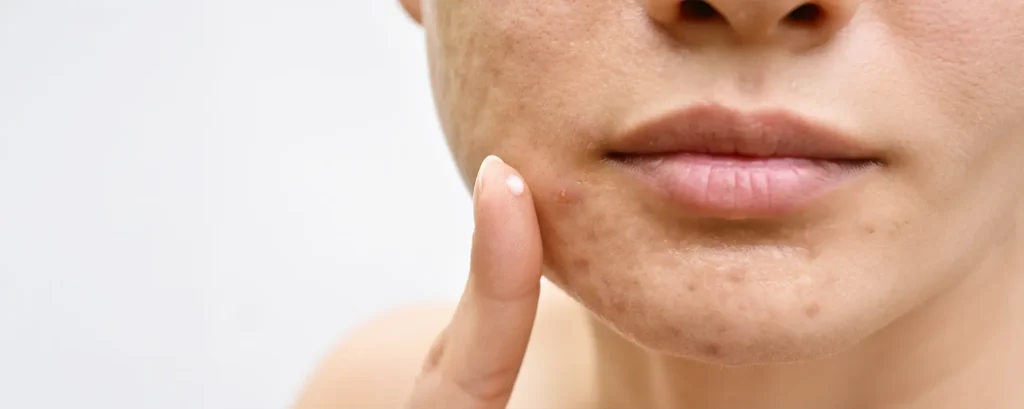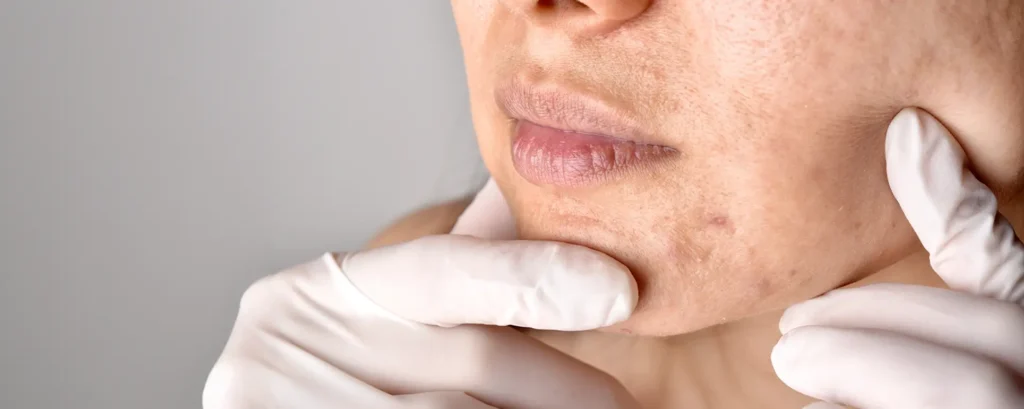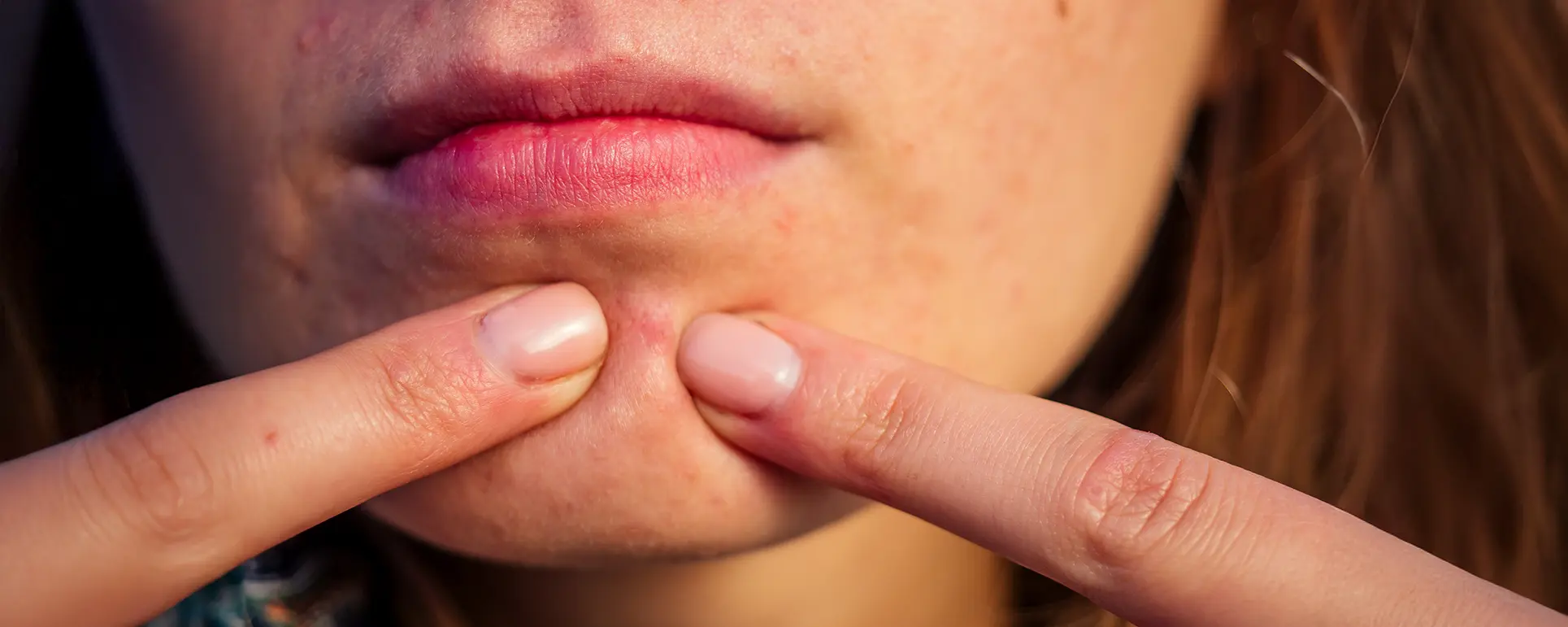Noticing spots, redness, or clusters of small bumps around your mouth can be both frustrating and concerning. For many, the first instinct is to think it’s just another acne flare-up, especially when the bumps look like tiny pimples. Some might even assume it’s an allergic reaction, a rash from using a new skincare product, or irritation caused by toothpaste or face masks. Because these breakouts often appear suddenly and can be stubborn, it’s easy to dismiss them as “just one of those skin issues” that will go away on its own.
However, not all blemishes around the mouth are acne. In fact, if you’ve noticed that the spots seem different from your usual breakouts perhaps they’re redder, more clustered, or even slightly itchy or burning you could actually be dealing with a separate condition known as perioral dermatitis. This skin issue tends to affect the area around the mouth, but it can also creep up near the nose or even around the eyes, making it both uncomfortable and distressing.
One of the reasons perioral dermatitis is so tricky to identify is because it mimics other skin problems. At a glance, it can resemble acne, rosacea, or even eczema. Yet beneath the surface, the causes are quite different. Acne, for instance, is typically linked to clogged pores and oil production, while perioral dermatitis is more of an inflammatory response often triggered by irritants or imbalances in the skin barrier. That’s why treatments that usually work for acne like heavy spot creams or thick moisturisers can sometimes backfire and actually make perioral dermatitis worse.
Because the condition can linger for weeks or even months if left untreated, it’s important not to ignore it or rely solely on home remedies. Many people find themselves caught in a frustrating cycle trying new creams, switching face washes, or cutting out certain foods only to see little improvement. Understanding that perioral dermatitis requires a different approach than acne can save time, reduce discomfort, and prevent unnecessary damage to your skin barrier.
What Causes Perioral Dermatitis?

Perioral dermatitis doesn’t develop overnight without reason. In most cases, it’s triggered by a mix of internal and external factors that disrupt the skin’s natural barrier or irritate sensitive areas around the mouth. Unlike acne, which is often linked to blocked pores and excess oil, this condition tends to flare when the skin becomes overstimulated or overexposed to certain products or environments. While the exact cause can differ from person to person, several common triggers stand out.
Topical Steroid Creams
One of the most frequent and well-documented causes is the overuse of topical steroid creams. These creams are often prescribed to manage inflammatory conditions such as eczema or psoriasis, but when applied to delicate facial skin for too long, they can have unintended side effects. Steroids work by calming inflammation, but prolonged use may thin the skin, reduce its resilience, and make it more reactive. In fact, many people notice their perioral dermatitis flares up once they stop using steroid creams, a rebound effect that can be frustrating and confusing. Even weaker, over-the-counter steroid ointments can set off this cycle if used repeatedly around the mouth or nose.
Toothpaste Ingredients
Your daily dental routine might also be playing a role. Certain toothpastes, especially those containing fluoride or foaming agents like sodium lauryl sulphate (SLS), can irritate the skin around the lips and mouth. Because brushing happens at least twice a day, that area is consistently exposed to these ingredients. For those with sensitive skin, this regular contact may lead to gradual irritation and inflammation. If you’ve ever noticed your breakouts worsening after brushing or appearing in the same pattern as toothpaste contact, it could be a sign that your oral care products are contributing. Switching to an SLS-free or fluoride-free toothpaste is often recommended as a first step in managing the condition.
Cosmetic and Skincare Products
Modern skincare routines can sometimes be overwhelming for sensitive skin. Thick, heavy creams, oil-based makeup, and products with strong fragrances or preservatives can clog pores or irritate the thin skin around the mouth. Unlike the rest of the face, this area is particularly delicate and doesn’t always tolerate rich formulations. For some, even “hydrating” products designed to protect can end up suffocating the skin and trapping heat, which encourages flare-ups. Layering multiple products serums, creams, sunscreen, makeup can also overload the skin barrier, leaving it more prone to inflammation and perioral dermatitis.
Hormonal and Environmental Triggers
Hormones and environmental factors also play a significant role. Many women notice perioral dermatitis flare-ups linked to hormonal fluctuations during their menstrual cycle, pregnancy, or when starting or stopping hormonal contraception. Stress is another major trigger, as it not only affects hormone balance but also compromises the immune system, making the skin more reactive. Environmental elements such as strong sunlight, cold winds, heat, and humidity can all exacerbate the condition. For example, UV rays can weaken the skin barrier over time, while hot, sweaty conditions may encourage irritation in already sensitive areas.
Other Possible Factors
In addition to the main triggers, lifestyle and health choices can also play a part. Over-washing the face with harsh cleansers, using exfoliants too frequently, or relying on strong acne treatments can strip the skin’s natural oils and increase sensitivity. Certain foods or drinks that are spicy, acidic, or overly processed may also worsen inflammation in some individuals, though this tends to vary widely. Even physical habits, like frequently touching your face or licking your lips, can introduce bacteria or irritants that contribute to flare-ups.
Overall, perioral dermatitis rarely has just one single cause. It is often the result of several triggers working together an overuse of steroid creams combined with harsh skincare, or hormonal shifts paired with environmental stressors. This makes it particularly important to look at the bigger picture of your skincare and lifestyle when trying to identify what’s fuelling your flare-ups.
What Not to Use

When it comes to managing perioral dermatitis, what you leave out of your routine can be just as important as what you include. Many people unintentionally make their condition worse by reaching for the wrong products, thinking they will soothe or clear the bumps. Unfortunately, some common remedies for acne or dryness actually have the opposite effect on this type of rash. Here are the main things to avoid if you want to give your skin the best chance to heal.
Steroid Creams
Topical steroid creams are one of the biggest culprits. While they are often prescribed for skin conditions like eczema and psoriasis, they are not suitable for long-term use around the mouth. Steroids suppress inflammation temporarily, so they may seem to “work” at first, but the relief doesn’t last. With repeated use, the skin can become thinner, more fragile, and dependent on the cream. The moment you stop applying it, a rebound flare usually follows, which can be more severe than the original problem. Even mild, over-the-counter steroid ointments can trigger this cycle, so it’s best to avoid them unless a dermatologist has specifically advised otherwise.
Harsh Scrubs and Strong Exfoliants
Exfoliation often feels like the go-to solution for bumps, but in the case of perioral dermatitis, scrubbing only makes matters worse. Physical exfoliants with beads, grains, or rough textures can cause tiny tears in the skin and intensify irritation. Strong chemical exfoliants, such as those with high concentrations of glycolic acid or salicylic acid, can also be too aggressive for already inflamed skin. Instead of clearing the rash, these products strip away essential protective oils, leaving the skin barrier weaker and more vulnerable.
Heavy Moisturisers and Occlusive Makeup
Thick creams, rich ointments, and oil-based products often do more harm than good for perioral dermatitis. These formulations tend to trap heat, sweat, and bacteria against the skin, which prevents healing and can worsen inflammation. The same issue applies to heavy makeup products, especially full-coverage foundations or concealers that sit on the skin all day. They not only clog pores but also make it harder for the skin to “breathe.” If makeup is necessary, lightweight, non-comedogenic formulas are a better choice, and applying them sparingly around the affected area can help minimise irritation.
Fragranced or Complex Skincare
Fragrance might make products smell appealing, but it’s one of the most common skin irritants. Whether synthetic or naturally derived, added fragrance increases the risk of redness, itching, and flare-ups in sensitive skin. The same goes for products with too many additives, preservatives, or essential oils, which may seem gentle but can still cause irritation when used regularly. For perioral dermatitis, it’s best to keep things simple choose basic, fragrance-free cleansers and moisturisers with short ingredient lists.
Irritating Oral Care Products
Because perioral dermatitis appears around the mouth, your toothpaste and mouthwash are worth examining. Fluoride and sodium lauryl sulphate (SLS) in toothpaste are well-documented irritants that can aggravate the skin when used daily. Mouthwashes with alcohol or strong antibacterial ingredients may also contribute to dryness and irritation around the lips. If flare-ups seem to coincide with brushing, switching to an SLS-free and fluoride-free toothpaste is a practical step.
Over-the-Counter Acne Treatments
It’s common for people to assume the bumps are just another form of acne and reach for spot treatments like benzoyl peroxide or drying gels. Unfortunately, these are far too harsh for perioral dermatitis and usually worsen inflammation rather than reduce it. Unlike acne, which benefits from pore-clearing and oil-control treatments, perioral dermatitis needs calming, barrier-supporting care. Using acne treatments on this condition often prolongs the healing process.
DIY Home Remedies
Finally, while it can be tempting to try home remedies such as applying apple cider vinegar, lemon juice, or toothpaste directly onto the skin, these methods almost always cause irritation. Natural doesn’t always mean gentle acidic or overly alkaline substances can strip the skin barrier and worsen redness and discomfort. It’s safer to avoid experimenting with such remedies and instead stick to dermatologist-approved products.
In short, the key principle for managing perioral dermatitis is to keep your skincare and oral care routine as minimal and non-irritating as possible. Avoiding steroids, harsh exfoliants, heavy occlusive products, and fragranced skincare gives your skin the chance to recover without unnecessary stress. The fewer irritants it has to fight against, the faster it can calm down and heal.
Dermatologist-Recommended Treatments

Because perioral dermatitis often doesn’t respond well to self-treatment or standard acne remedies, it’s essential to seek professional guidance. Dermatologists tailor treatment plans based on the severity of the condition, the patient’s skin type, and potential triggers. The goal isn’t only to calm the current flare-up but also to prevent the rash from recurring.
Topical or Oral Antibiotics
Antibiotics are one of the most effective tools in managing perioral dermatitis, not because the condition is purely bacterial, but because of their anti-inflammatory properties. Topical antibiotics such as metronidazole, clindamycin, or erythromycin are often prescribed first for mild to moderate cases. These gels or creams are applied directly to the rash and gradually reduce redness and swelling. For more persistent or widespread flare-ups, oral antibiotics like doxycycline or minocycline may be recommended for a period of 6–12 weeks. These help calm the inflammatory response and reset the skin, but they are always used under close supervision to ensure safe and effective results.
Gentle Skincare Routine
Dermatologists frequently remind patients that less is more when it comes to skincare during treatment. A simplified routine with a fragrance-free cleanser and a lightweight moisturiser is usually sufficient. Harsh cleansers, foaming face washes, and abrasive scrubs strip away the skin’s natural oils, worsening sensitivity. Instead, look for soothing formulations with ingredients such as ceramides to strengthen the skin barrier, hyaluronic acid to provide hydration, and niacinamide to reduce redness and irritation. Sunscreen is still crucial to protect against UV damage, but mineral-based sunscreens are often preferred because they’re less likely to irritate sensitive skin.
Avoiding Triggers
Another major part of treatment is cutting out known irritants. A dermatologist may suggest switching to a toothpaste free from fluoride and sodium lauryl sulphate, since these ingredients commonly aggravate the condition. Thick, oily creams, full-coverage makeup, and layered skincare routines should be scaled back or replaced with non-comedogenic alternatives. Many dermatologists also recommend avoiding topical steroids unless absolutely necessary, as they are one of the biggest triggers of flare-ups. By eliminating these irritants, the skin has a better chance to heal naturally without constant setbacks.
Regular Monitoring and Adjustments
Because perioral dermatitis can behave unpredictably, regular follow-ups are essential. A dermatologist will check whether the current treatment is working and adjust as needed. For example, if topical antibiotics alone aren’t improving the rash, oral medications may be added. In some cases, dermatologists may also explore whether hormonal factors, stress, or lifestyle habits are contributing. This ongoing monitoring helps fine-tune treatment and prevents the condition from becoming long-term or chronic.
Lifestyle and Holistic Care
Treatment doesn’t stop at prescriptions dermatologists often recommend lifestyle changes to support healing. Managing stress through relaxation techniques, yoga, or exercise can reduce flare-ups, as stress hormones are known to impact skin health. Protecting the skin from harsh weather conditions, such as cold winds or strong sunlight, also helps minimise irritation. Patients are usually encouraged to keep a skin diary to track changes, note down potential triggers, and monitor progress over time.
Patience and Consistency
One of the most important messages dermatologists share is that perioral dermatitis takes time to heal. Even with the right treatment, visible improvement may only start after a few weeks, and complete clearing can take longer. It’s normal for the condition to fluctuate before it gets better, which is why consistency is crucial. Sticking to the prescribed plan, resisting the urge to add new products, and following up regularly ensures the best outcome.
Final Thought: Managing Perioral Dermatitis the Right Way
If you notice persistent breakouts or redness around your mouth, it may be perioral dermatitis rather than regular acne. Avoid self-treating with steroids or harsh products. For expert care, you can consult our Acne Clinic in London, where dermatologists can provide safe and effective treatments tailored to your skin type.
References:
- Tolaymat, L., Syed, H.A. & Hall, M.R. (2025) Perioral Dermatitis. In: StatPearls [Internet]. Treasure Island (FL): StatPearls Publishing. Available at: https://www.ncbi.nlm.nih.gov/books/NBK525968/
- British Association of Dermatologists (2019) Peri-oral Dermatitis – Patient Information Leaflet. London: BAD. Available at: https://www.bad.org.uk/pils/peri-oral-dermatitis/
- Peters, P. & Drummond, C. (2013) ‘Perioral dermatitis from high fluoride dentifrice: a case report and review of literature’, Australian Dental Journal, 58(3), pp. 371–372. https://onlinelibrary.wiley.com/doi/10.1111/adj.12077
- Primary Care Dermatology Society (2023) Perioral Dermatitis Patient Information Leaflet. Available at: https://www.pcds.org.uk/patient-info-leaflets/perioral-dermatitis
- Shah, N. (2022) ‘Periorificial dermatitis’, DermNet NZ. Available at: https://dermnetnz.org/topics/periorificial-dermatitis
